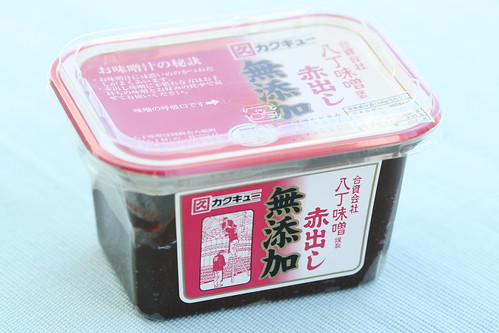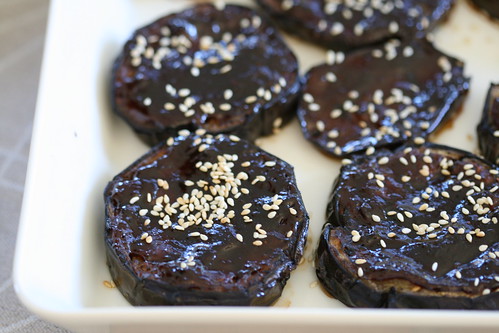
You'll get two Japanese recipes in a row now - on Friday I blogged about tonkatsu (breaded pork cutlets, Japanese style) today's blog post is dedicated to nasu dengaku or miso-glazed aubergine/eggplant. I first made this for the Japanese feast at our place back in summer 2009 (pictured above), but I've made them on several occasions since (and it has become one of my favourite cousin Ingrid's favourite dishes ever).
It's an easy and very flavoursome dish to make. All you need is some nice small aubergines (slim Japanese ones are best, but ordinary bulbous ones will do), some miso paste (I used hatcho and shiro miso pastes) and sesame seeds. I was lucky to use an additive-free dark hatcho miso that's typical to the Aichi Prefecture in Japan (thank you, Ryoko!!!):

Here's the recipe, should you want to make this at home, using the non-Japanese eggplants:
Nasu dengaku
(Eestikeelne retsept)
Serves four to six

1 large or 2 smaller eggplants/aubergines
vegetable oil
Miso-glaze:
6 Tbsp miso paste
4 Tbsp mirin or sweet rice wine
2 Tbsp sake or dry sherry
2 Tbsp caster sugar
Topping:
sesame seeds
Rinse and dry the eggplant and cut into 1 cm thick slices, crosswise. Make some slashes with a sharp knife onto one side of the vegetable slices. Brush both sides with oil, then place onto an oven sheet and bake in a 200 C oven for 15-20 minutes, turning once - you want the aubergine slices to be nicely brown on top. (Alternatively - fry on a griddle pan until golden brown on both sides).
Place the grilled/fried aubergine slices onto a large oven sheet - or even better, onto a heat-proof serving tray - on one layer:

Make the miso glaze. Mix all the ingredients in a small saucepan. Bring slowly to the boil, then reduce heat and simmer, stirring all the time, until the glaze is thickened slightly and nice and shiny. Remove from the heat.

Spread a spoonful of miso-glaze on each aubergine/eggplant slice, sprinkle some sesame seeds on top.
Put under a hot grill for a few minutes, then serve either hot or at room temperature.















